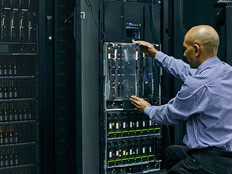Feds Can Turn to New Kinds of IT Infrastructure to Get Ahead of the Curve
Federal agencies have a mountain of legacy IT systems they are eager to upgrade. They are also mandated to consolidate and upgrade their data centers and to embrace virtualization technologies as part of that process. And the White Hosue has provided clear direction that it wants agencies to be more aggressive in adopting commercial cloud technologies.
New technologies are fueling innovation, along with efficiency and productivity gains in the private sector and the government. Digital transformation is changing the workplace significantly, delivering capabilities that enable government users to work from anywhere and collaborate more effectively.
But such gains come at the cost of increased complexity. IT teams are required to manually configure every new technology — such as mobile devices, wearables and other sensors — that connects to an enterprise network. They must ensure both that these devices are secure and that they access only the appropriate resources. As the number of devices has climbed, IT teams have had to devote more resources to keep pace with demand.
Organizations in just about every industry are stuck on the same treadmill. Digital advancements such as mobility, cloud computing and the Internet of Things are increasing the speed of operations and opening new opportunities for innovations in areas such as collaboration and smart buildings, but they also add pressure on IT staff to manage increasingly complex digital footprints.
SIGN UP: Get more news from the FedTech newsletter in your inbox every two weeks!
A Connected World Demands New IT Solutions
“In a world where you’re connecting all people, devices and things, it’s complex,” says Laura DiDio, principal analyst at Information Technology Intelligence Consulting. “You have a lot more capabilities and intelligence, but there are also a lot more potential points of failure. And if something goes wrong, if everything is connected, that can have a domino effect.”
While the demands are growing exponentially, most federal IT teams are not getting additional resources, adds Raakhee Mistry, director of marketing for enterprise networks at Cisco Systems. Indeed, according to the federal IT Dashboard, total government IT spending for fiscal year 2019 climbed to $83.4 billion, up 2.6 percent from $81.3 billion in fiscal year 2018.
“They’re spending upwards of 80 percent of their days just keeping the lights on,” she says. “But business leaders need them to move on to more strategic projects that enable new capabilities in their environment.”
Rather than continuing to run in place, agencies are turning to new technologies to help them get ahead of today’s digital advancements. More flexible networks, real-time analytics, hyperconverged infrastructures, edge computing and faster storage are automating and simplifying complex digital environments so IT teams – and the users they support — can work smarter and faster, and be more agile.
These solutions enable innovative capabilities such as workplace analytics that help organizations gain new insights on how users are working to foster greater productivity and efficiency. Digital advancements also support changing workstyles. Users who can remain effective at their jobs from anywhere at any time are more likely to be satisfied, productive employees. Further, next-generation collaboration and communication solutions are powering a change in the workplace. Delivering better information-sharing and workplace flexibility fuels innovation.
“There’s been a lot of turmoil and incredible innovation that’s come out of this transition,” says Krishnan Badrinarayanan, director of product marketing at Nutanix.
Hyperconverged Infrastructure Can Help Feds Simplify IT
Many agencies also struggle to maintain an IT infrastructure that can keep pace with government mandates and changes in commercial technology. Hyperconverged infrastructure solutions from vendors such as Nutanix, Cisco Systems and HPE can significantly change their IT operations to meet this challenge.
Instead of following the traditional IT model with teams working in specialty areas — such as servers, storage and networking — hyperconvergence collapses these silos and converts the parts of the infrastructure into one stack (virtualized network, hypervisor and software-defined storage) that can be quickly provisioned.
A single team can stand up infrastructure on demand, automate and orchestrate the deployment of applications, ensure performance and scale up or down based on market demands, Badrinarayanan says. These capabilities support the rapidly changing demands of the digital workplace, ensuring that users have the tools they need to remain productive and efficient.
Hyperconvergence offers the agility of a cloud services platform with the flexibility to adapt technology at the hardware level, choosing from an array of products that can be swapped in and out as needed without being locked in with a particular vendor.
“It’s really offering choice and allowing the application development teams to pick the best-of-breed technologies while experiencing cloud-like behavior and benefits within the organization,” Badrinarayanan says.
Why Agencies Need a Next-Generation Storage Architecture
Data is at the heart of digital transformation. Tools such as artificial intelligence and workplace analytics have the power to use data to improve operations, generate new services and help agencies achieve their missions. But storing this data is another challenge.
“A next-generation data center cannot be, by its very nature, reliant on traditional storage infrastructure,” says Jeff McCullough, vice president of Americas partner sales at NetApp. Rather, agencies need a next-generation storage architecture, “one that is inherently agile, scalable and predictable,” he says.
Storage speed, low-latency performance and the scalability to accommodate petabytes of data have become critical in today’s digital environment. Software-defined storage offers such benefits and allows storage resources to be abstracted from the underlying physical storage hardware for added flexibility, McCullough explains.
Flash technology provides far greater read and write speeds than spinning disk storage, and advances such as Nonvolatile Memory Express, NVMe over Fabrics and storage class memory offer promising capabilities. But McCullough believes organizations should be able to adapt their storage based on their needs, moving data from flash to disk to cloud and back. “There’s not one single storage media to rule them all,” he says.
Learn more about how CDW solutions and services can help manage and secure your digital transformation efforts.








